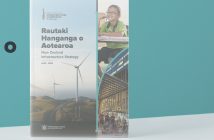The new government inherits an intriguing set of circumstances, including a growing population, a pressing need to deliver disaster recovery, and an infrastructure deficit, Infrastructure Partnerships Australia says

| Considered altogether, it seems appropriate to consider the New Zealand infrastructure market as at the precipice of an inflexion point. However, with tumult comes the knock of opportunity.
The Australian and New Zealand Infrastructure Pipeline (ANZIP) currently tracks a healthy pipeline of major infrastructure across the Trans-Tasman market – projects with a capital value over A$300 million in the Australian market, and over NZ$100 million in New Zealand – with the Kiwi market contributing A$88.5 billion (NZ$95.9 billion) worth of infrastructure across 64 projects. In contrast to the Australian pipeline, which has many large-scale projects at the pointy end of delivery, the New Zealand pipeline is heavily skewed toward the front end. A number of major projects are in the early stages of planning – such as Waitemata Harbour Connections, Otaki to North of Levin and the Nelson Hospital Redevelopment – while others in planning are now on the ‘at risk’ register following the election – including Auckland Light Rail, Let’s Get Wellington Moving Program, and the Lake Onslow Pumped Hydro. Figure 1 provides a stage-by-stage breakdown of New Zealand’s pipeline. |
Despite a number of at-risk projects, the new Government came to the election committed to growing the transport pipeline through a 10-year NZ$24.8 billion (A$23 billion) Transport for the Future investment. The projects in this policy will be either fully or partially funded by the Government. Key projects include:
Included in the Transport for the Future policy document is a commitment to investigate all options for funding and financing transport infrastructure, including using private finance in the delivery of transport infrastructure. Key projects earmarked for private finance include:
Prior to any pipeline cancellations or additions, delivery of New Zealand’s pipeline is forecast to accelerate. Over the next five years, quarterly expenditure on infrastructure will grow from A$920 million (NZ$1 billion) to A$1.9 billion (NZ$2.1 billion) and average A$1.7 billion (NZ$1.8 billion), equating to A$554 million (NZ$600 million) in major infrastructure expenditure hitting the ground each month in New Zealand. Elected with an infrastructure mandate, the new Government should be granted a grace period as changes are made to its pipeline, including selecting projects and how they are delivered. However, to ensure smooth operation of a growing pipeline, the Government must move quickly to establish project certainty and provide necessary funding. Delays in establishing a firm pipeline of funded projects could have ramifications for service delivery and see a busy Trans-Tasman industry flow to markets with greater certainty. While many of the resources for New Zealand’s infrastructure market can be drawn from domestic capability, New Zealand has always had to contend with the two-way task of attracting and retaining capital, plant and labour from Trans-Tasman neighbour Australia. The scale of this challenge is set to become more difficult, with quarterly infrastructure expenditure in Australia rising to an average of A$20.6 billion over the next five years. Figure 2 shows the forecast expenditure for New Zealand and Australian jurisdictions on ANZIP. |
|
As New Zealand’s pipeline grows, so does the labour force required to deliver it. Labour demand for infrastructure workers in New Zealand is forecast to grow by over 130 per cent of current levels by the middle of 2026, while labour demand in Australia is set to grow by over 40 per cent in the same period. Figure 3 shows labour demand forecasts for New Zealand and Australian jurisdictions indexed to this quarter. |
|
These expenditure and labour demand figures may look like a difficult task for the country but on closer inspection, there is a possibility that New Zealand is able to attract capital, plant and skilled labour from across the ditch. Australia is currently experiencing a major boom in the delivery of energy projects – expenditure is set to average A$8 billion per quarter over the next five years – while the previous boom in transport projects is cooling with rail expenditure to average A$5.3 billion per quarter and road expenditure A$3.5 billion over the next five years. Conversely, there is only one major energy project in New Zealand currently on ANZIP – with New Zealand’s pipeline made up of over 60 per cent transport projects. Figure 4 shows the sectoral makeup of New Zealand’s pipeline. |
|
It is generally true that companies required by major infrastructure projects – from engineering consultancies, planners and designers through to contractors – are, to some extent, sub-sector agnostic. However, there are teams and individuals that have honed a particular set of skills on transport projects in Australia that would jump at the opportunity to redeploy them in the New Zealand divisions of their firms. With transport pipelines at different stages, there is much for infrastructure planners on both sides of the Tasman to consider when attempting to retain or attract this talent. For New Zealand, attracting and retaining sufficient capital, plant and labour will require a steadfast collaborative effort from the public and private sectors. Continued focus should be applied to traditional matters including fostering an attractive business and investment environment, transparent procurement, and a firm pipeline. New Zealand, however, as “the last bus stop on the planet”, has a unique set of circumstances which can work for and against its interests. Smaller advanced economies can benefit significantly from taking the lead on principles and technologies – such as sustainable construction methods, digital engineering and artificial intelligence in design and operation. And the New Zealand Government, blessed with the capacity to be flexible and adapt quickly, should focus on increasing their responsiveness to market conditions to deliver their important infrastructure pipeline. |












